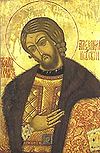- Pyotr Kozlov
-

Pyotr Kuzmich Kozlov (Russian: Пётр Кузьми́ч Козло́в; October 3, 1863, Dukhovshchina – September 26, 1935, Peterhof) was a Russian and Soviet traveler and explorer who continued the studies of Nikolai Przhevalsky in Mongolia and Tibet.
Although prepared by his parents for military career, Kozlov chose to join Przhevalsky's expedition. After his mentor's death, Kozlov continued travelling in Asia with his successors, Pevtsov and Roborovsky. In 1895, he took general command of the expedition from ailing Roborovsky. From 1899 to 1901 he explored and later described in a book the upper reaches of Huang He, Yangtze, and Mekong rivers.
During the first decade of the 20th century, when the Great Game reached its peak, Kozlov rivalled Sven Hedin and Aurel Stein as the foremost researcher of Xinjiang. Although he was on good terms with Hedin and other foreign explorers, the British government, as represented by George Macartney, monitored his movements across Central Asia. Kozlov's 1905 visit to the Dalai Lama in Urga gave "the British War Office a fright",[1] especially after the Lama declared his intention to "settle within the confines of Russia".[2]
During the expedition of 1907–1909, Kozlov explored the Gobi Desert and discovered remains of Khara-Khoto, a Tangut city ruined by the Ming Chinese in 1372. It took him several years to excavate the site and bring to St. Petersburg no less than 2,000 books in Tangut language he uncovered there. Kozlov described his findings in a bulky volume entitled Mongolia and Amdo and the Dead City of Khara-Khoto (1923).
His last expedition to Mongolia and Tibet (1923–1926) resulted in discovery of an unprecedented number of Xiongnu royal burials at Noin-Ula. After bringing to Petrograd some amazing samples of 2000-year-old Bactrian textiles, Kozlov retired from scientific work and settled in a village near Novgorod.
Kozlov married Elizabeth V. Kozlova, a woman 29 years his junior, who accompanied him on his final journey of exploration as the expedition ornithologist, and who was to publish many monographs and scientific papers on the avifauna of Central Asia.
References
- General
 Media related to Pyotr Kuzmich Kozlov at Wikimedia Commons
Media related to Pyotr Kuzmich Kozlov at Wikimedia Commons- Inline
- ^ Palace, Wendy. The British Empire and Tibet, 1900-1922. Routledge, 2005. ISBN 0415346827. Page 71.
- ^ Andreyev, Alexandre. Soviet Russia and Tibet: The Debacle of Secret Diplomacy, 1918-1930s. Brill Publishers, 2003. ISBN 9004129529. Page 29.
People from Russia Leaders and religious - Pre-1168
- 1168–1917
- 1922–1991
- 1991–present
- RSFSR leaders
- General secretaries
- Soviet premiers (1st deputies)
- Soviet heads of state (and their spouses)
- Prime ministers (1st deputies)
- Foreign ministers
- Prosecutors general
- Metropolitans and patriarchs
- Saints

Military and explorers - Field marshals
- Soviet marshals
- Admirals
- Aviators
- Cosmonauts
Scientists and inventors - Aerospace engineers
- Astronomers and astrophysicists
- Biologists
- Chemists
- Earth scientists
- Electrical engineers
- IT developers
- Linguists and philologists
- Mathematicians
- Naval engineers
- Physicians and psychologists
- Physicists
- Weaponry makers
Artists and writers Sportspeople - Chess players
Categories:- 1863 births
- 1935 deaths
- Explorers of Asia
- Explorers of Central Asia
- People from Dukhovshchina
- Russian archaeologists
- Russian explorers
- Russian orientalists
Wikimedia Foundation. 2010.
